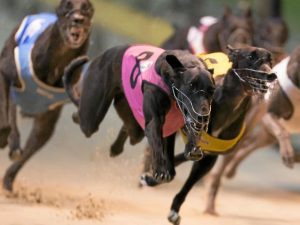
“RSPCA Australia supports the development of mandatory welfare standards for all racing codes which prescribe the cancellation of races above a specific temperature. Addressing this issue requires urgent attention given climate change predictions.” – RSPCA website
Racing in extreme heat is yet another area where the racing industry and state governments fail to protect the dogs they exploit day after day.
Despite this, there are no consistent rules that prohibit greyhound racing in Australia above a specific temperature. Meanwhile, prolonged and untreated heat stress can lead to dehydration, collapse and death. Individual animals will respond to excess heat differently, but on very hot days most animals will be affected in some way.Some state racing bodies have developed heat policies which provide guidance, but they do not prescribe a maximum temperature at which to cancel races. This leads to individual racing clubs making their own ad hoc decisions, as well as greyhounds suffering heat-related conditions, some of which can lead to death. CPG’s view is that 31°C should be the cut-off point for greyhound racing.
The need for a mandated maximum temperature
The RSPCA recommends that state governments introduce mandatory enforceable welfare standards for greyhound racing, including a capped temperature at which races must be cancelled.
An Australian study in 2016 of 229 racing greyhounds showed that their core body temperature after racing had equalled or exceeded the critical level of 41.5°C (when the ambient temperature averaged 31.2°C).
The study says – “Many authors consider a rectal temperature ≥41.5°C to be a critical level for initiation of heat illness in dogs (11, 54, 58, 66, 67). During the current study, 45 greyhounds recorded a post- race rectal temperature >41.5°C which if not reduced, would place them at risk of heat illness. The mean ambient temperature at the time of these races was 31.2°C…
Therefore, 31°C might represent a threshold for risk estimation for heat stress in racing greyhounds. Such a threshold might be broadly accepted by participants in the greyhound racing industry, as there is a common perception amongst trainers of greyhounds that, at ambient temperatures >30°C, the animals show signs of thermal stress such as panting, which concurs with evidence from experimental settings (68).”
The study also showed that large, dark-colored greyhounds are at greater risk of developing high body temperature than small, light-colored greyhounds.
